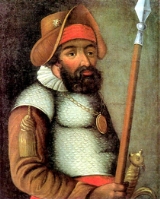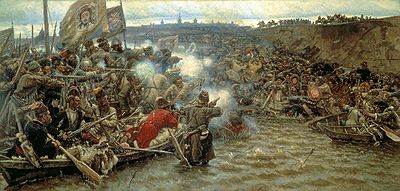
Yermak Timofeyevich
Encyclopedia

Cossack
Cossacks are a group of predominantly East Slavic people who originally were members of democratic, semi-military communities in what is today Ukraine and Southern Russia inhabiting sparsely populated areas and islands in the lower Dnieper and Don basins and who played an important role in the...
leader, Russia
Russia
Russia or , officially known as both Russia and the Russian Federation , is a country in northern Eurasia. It is a federal semi-presidential republic, comprising 83 federal subjects...
n folk hero
Folk hero
A folk hero is a type of hero, real, fictional, or mythological. The single salient characteristic which makes a character a folk hero is the imprinting of the name, personality and deeds of the character in the popular consciousness. This presence in the popular consciousness is evidenced by...
and explorer of Siberia
Siberia
Siberia is an extensive region constituting almost all of Northern Asia. Comprising the central and eastern portion of the Russian Federation, it was part of the Soviet Union from its beginning, as its predecessor states, the Tsardom of Russia and the Russian Empire, conquered it during the 16th...
. His exploration of Siberia marked the beginning of the expansion of Russia
Russia
Russia or , officially known as both Russia and the Russian Federation , is a country in northern Eurasia. It is a federal semi-presidential republic, comprising 83 federal subjects...
towards this region and its colonization. ("Timofeyevich" is his patronimic
Patronymic
A patronym, or patronymic, is a component of a personal name based on the name of one's father, grandfather or an even earlier male ancestor. A component of a name based on the name of one's mother or a female ancestor is a matronymic. Each is a means of conveying lineage.In many areas patronyms...
, not the last name
Family name
A family name is a type of surname and part of a person's name indicating the family to which the person belongs. The use of family names is widespread in cultures around the world...
, so in references he must be looked up as "Yermak" or "Yermak Timofeyevich"; his last name, if any, is unknown).
In the mid 16th century the Tsardom of Russia
Tsardom of Russia
The Tsardom of Russia was the name of the centralized Russian state from Ivan IV's assumption of the title of Tsar in 1547 till Peter the Great's foundation of the Russian Empire in 1721.From 1550 to 1700, Russia grew 35,000 km2 a year...
conquered the Tatar khanates of Kazan
Khanate of Kazan
The Khanate of Kazan was a medieval Tatar state which occupied the territory of former Volga Bulgaria between 1438 and 1552. Its khans were the patrilineal descendants of Toqa Temür, the thirteenth son of Jochi and grandson of Genghis Khan. The khanate covered contemporary Tatarstan, Mari El,...
and Astrakhan
Astrakhan Khanate
The Khanate of Astrakhan was a Tatar feudal state that appeared after the collapse of the Golden Horde. The Khanate existed in the 15th and 16th centuries in the area adjacent to the mouth of the Volga river, where the contemporary city of Astrakhan/Hajji Tarkhan is now located...
, thus annexing the entire Volga Region
Volga Region
Volga Region is a historical region of Russia that encompasses the territories adjacent to the flow of Volga River. According to the flow of the river, it is usually classified into the Middle Volga Region and Lower Volga Region...
and making the way to the Ural Mountains
Ural Mountains
The Ural Mountains , or simply the Urals, are a mountain range that runs approximately from north to south through western Russia, from the coast of the Arctic Ocean to the Ural River and northwestern Kazakhstan. Their eastern side is usually considered the natural boundary between Europe and Asia...
open. The colonisation of the new easternmost lands of Russia and further onslaught eastward was led by the rich merchants Stroganovs. Tsar
Tsar
Tsar is a title used to designate certain European Slavic monarchs or supreme rulers. As a system of government in the Tsardom of Russia and Russian Empire, it is known as Tsarist autocracy, or Tsarism...
Ivan IV granted large estates near the Urals as well as tax privileges to Anikey Stroganov
Anikey Stroganov
Anikey Stroganov was a founder of numerous salterns in Solvychegodsk and Perm, a colonizer of the basin of the Kama and Chusovaya Rivers. He was the progenitor of the family of highly successful Russian merchants, industrialists, landowners, and statesmen.Anikey Stroganov was the fourth and...
, who organized large scale migration to these lands. Stroganovs developed farming, hunting, saltworks, fishing, and ore mining on the Urals and established trade with Siberia
Siberia
Siberia is an extensive region constituting almost all of Northern Asia. Comprising the central and eastern portion of the Russian Federation, it was part of the Soviet Union from its beginning, as its predecessor states, the Tsardom of Russia and the Russian Empire, conquered it during the 16th...
n tribes.

Stroganovs
The Stroganovs or Strogonovs , also spelled in French manner as Stroganoffs, were a family of highly successful Russian merchants, industrialists, landowners, and statesmen of the 16th – 20th centuries who eventually earned nobility.-Origins:...
received their first patent for colonizing "the abundant region along the Kama River
Kama River
Kama is a major river in Russia, the longest left tributary of the Volga and the largest one in discharge; in fact, it is larger than the Volga before junction....
", and in 1574 lands over the Ural Mountains
Ural Mountains
The Ural Mountains , or simply the Urals, are a mountain range that runs approximately from north to south through western Russia, from the coast of the Arctic Ocean to the Ural River and northwestern Kazakhstan. Their eastern side is usually considered the natural boundary between Europe and Asia...
along the rivers Tura
Tura River
Tura River , also known as Dolgaya River ) is a historically important Siberian river which flows eastward from the central Ural Mountains into the Tobol River, a part of the Ob River basin. The main town is Tyumen....
and Tobol. They also received permission to build forts along the Ob
Ob River
The Ob River , also Obi, is a major river in western Siberia, Russia and is the world's seventh longest river. It is the westernmost of the three great Siberian rivers that flow into the Arctic Ocean .The Gulf of Ob is the world's longest estuary.-Names:The Ob is known to the Khanty people as the...
and Irtysh rivers. Around 1577, the Stroganovs hired the Cossack leader Yermak to protect their lands from attacks of the Siberian Khan
Khan (title)
Khan is an originally Altaic and subsequently Central Asian title for a sovereign or military ruler, widely used by medieval nomadic Turko-Mongol tribes living to the north of China. 'Khan' is also seen as a title in the Xianbei confederation for their chief between 283 and 289...
Kuchum
Kuchum
Kuchum khan Kuchum khan (Tatar: Küçüm, Күчүм, Russian: Кучум; in Sybyr Küçüm is pronounced approximately as /kytsym/ - Күцүм, English name comes from standard Tatar pronunciation)Kuchum khan (Tatar: Küçüm, Күчүм, Russian: Кучум; in Sybyr Küçüm is pronounced approximately as /kytsym/ - Күцүм,...
.
In 1581 Yermak began his voyage into the depths of Siberia, that led to the conquest of the Khanate of Sibir
Conquest of the Khanate of Sibir
The Khanate of Sibir was a Muslim state located just east of the middle Ural Mountains. Its conquest by Ermak in 1582 was the first event in the Russian conquest of Siberia.-Russia:...
. After a few victories over the khan's army, Yermak's people defeated Kuchum's main forces after a 3-day battle (October 23–25, 1582) on the banks of Irtysh
Battle of Chuvash Cape
The Battle of Chuvash Cape led to the victory of a Russian expedition under Yermak Timofeyevich and the fall of Siberia Khanate and the end of Khan Kuchum's power. The battle took place near Qashliq .-Context:...
. The remains of the khan's army retreated to the steppes. On October 26, Yermak captured the capital of the Siberia Khanate
Siberia Khanate
The Khanate of Sibir were the patrilineal descendants of Shayban , the fifth son of Jochi and grandson of Genghis Khan. The Khanate had an ethnically diverse population of Siberian Tatars, Khanty, Mansi, Nenets and Selkup people. Along with the Khanate of Kazan it was the northernmost Muslim state....
, Qashliq
Qashliq
Qashliq, Isker or Sibir was a medieval Siberian Tatar fortress, in the 16th century the capital of the Khanate of Sibir, located on the right bank of the Irtysh River at its confluence with the Sibirka rivulet, some 17 km from the modern city of Tobolsk.The fortress is first mentioned in...
(17 km from the city of Tobolsk
Tobolsk
Tobolsk is a town in Tyumen Oblast, Russia, located at the confluence of the Tobol and Irtysh Rivers. It is a historic capital of Siberia. Population: -History:...
). Since Kuchum still had enough forces to resist, he suddenly attacked Yermak on August 6, 1585 in the dead of night and killed most of his people. Yermak was wounded and tried to swim across the Wagay River (Irtysh's tributary), but drowned under the weight of his own chain mail
Mail (armour)
Mail is a type of armour consisting of small metal rings linked together in a pattern to form a mesh.-History:Mail was a highly successful type of armour and was used by nearly every metalworking culture....
. The remains of Yermak's forces under the command of M. Mescheryak retreated from Qashliq.
Yermak's Cossacks had to withdraw from Siberia completely, but every year new bands of hunters and adventurers, supported by Moscow, poured into the country. Thanks to Yermak's having explored all the main river routes in West Siberia
Siberia
Siberia is an extensive region constituting almost all of Northern Asia. Comprising the central and eastern portion of the Russian Federation, it was part of the Soviet Union from its beginning, as its predecessor states, the Tsardom of Russia and the Russian Empire, conquered it during the 16th...
, Russians successfully reclaimed all Yermak's conquests just several years later.
Yermak's exploration of Siberia is reflected in the so-called Siberian Chronicles
Siberian Chronicles
The Siberian Chronicles are the Russian chronicles of the late 16th - 18th centuries on the history of Siberia. They include the Yesipov Chronicle, Kungur Chronicle, Remezov Chronicle, Stroganov Chronicle, and others. These chronicles represent a valuable source on the early history of the Russian...
. His life and death have been subjects for numerous Russian songs, books, and paintings since the 16th century. In 1995 a historical biopic "Yermak" was shot.
.
See also
- Icebreaker YermakIcebreaker YermakYermak was a Russian and later Soviet icebreaker, the first polar icebreaker in the world, having a strengthened hull shaped to ride over and crush pack ice....
- History of SiberiaHistory of SiberiaThe early history of Siberia is greatly influenced by the sophisticated nomadic civilizations of the Scythians and Xiongnu , both flourishing before the Christian era. The steppes of South Siberia saw a succession of nomadic empires, including the Turkic Empire and the Mongol Empire...
- Exploration of Siberia
- Exploration of Asia
- Russian conquest of SiberiaRussian conquest of SiberiaThe Russian conquest of Siberia took place in the 16th and 17th centuries, when the Siberian Khanate had become a loose political structure of vassalages which were becoming undermined by the activities of Russian explorers who, though numerically outnumbered, pressured the various family-based...
- Conquest of the Khanate of SibirConquest of the Khanate of SibirThe Khanate of Sibir was a Muslim state located just east of the middle Ural Mountains. Its conquest by Ermak in 1582 was the first event in the Russian conquest of Siberia.-Russia:...

